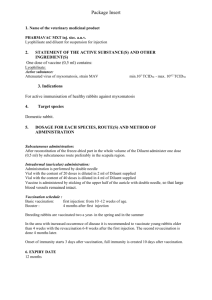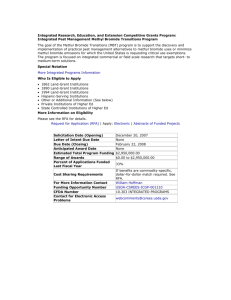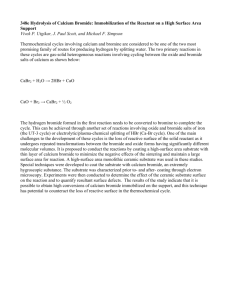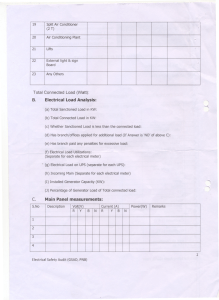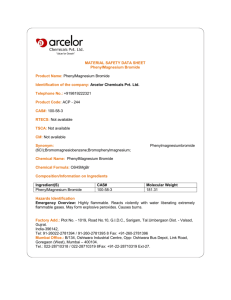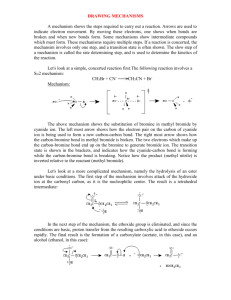Document 13309663
advertisement
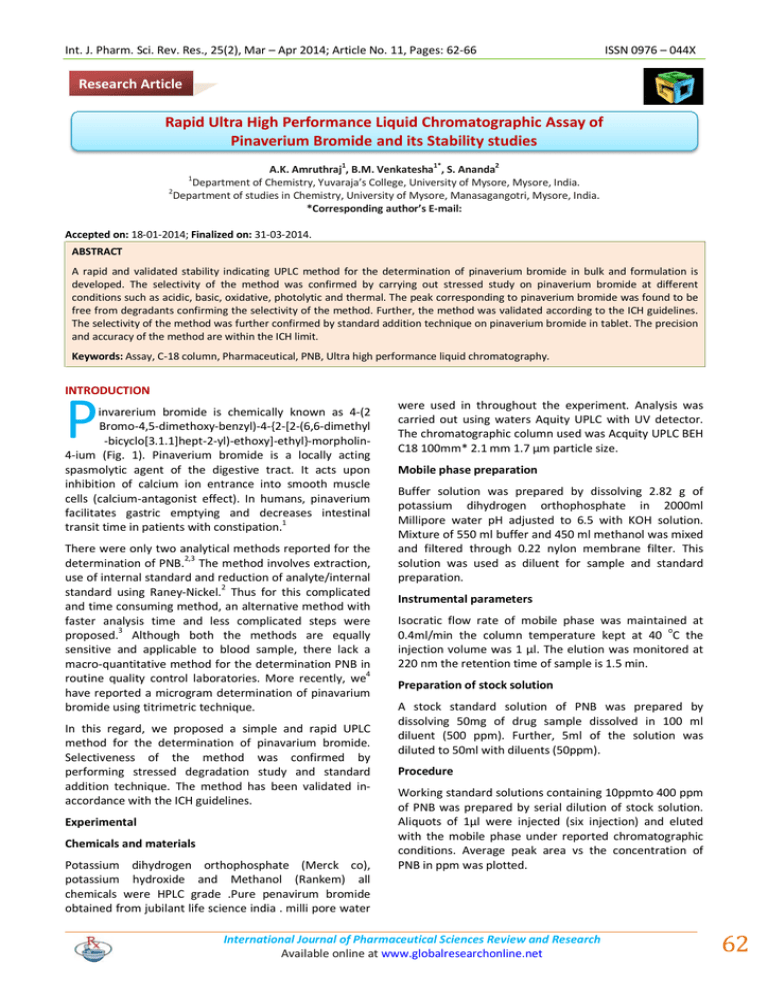
Int. J. Pharm. Sci. Rev. Res., 25(2), Mar – Apr 2014; Article No. 11, Pages: 62-66
ISSN 0976 – 044X
Research Article
Rapid Ultra High Performance Liquid Chromatographic Assay of
Pinaverium Bromide and its Stability studies
1
1*
2
A.K. Amruthraj , B.M. Venkatesha , S. Ananda
Department of Chemistry, Yuvaraja’s College, University of Mysore, Mysore, India.
2
Department of studies in Chemistry, University of Mysore, Manasagangotri, Mysore, India.
*Corresponding author’s E-mail:
1
Accepted on: 18-01-2014; Finalized on: 31-03-2014.
ABSTRACT
A rapid and validated stability indicating UPLC method for the determination of pinaverium bromide in bulk and formulation is
developed. The selectivity of the method was confirmed by carrying out stressed study on pinaverium bromide at different
conditions such as acidic, basic, oxidative, photolytic and thermal. The peak corresponding to pinaverium bromide was found to be
free from degradants confirming the selectivity of the method. Further, the method was validated according to the ICH guidelines.
The selectivity of the method was further confirmed by standard addition technique on pinaverium bromide in tablet. The precision
and accuracy of the method are within the ICH limit.
Keywords: Assay, C-18 column, Pharmaceutical, PNB, Ultra high performance liquid chromatography.
INTRODUCTION
P
invarerium bromide is chemically known as 4-(2
Bromo-4,5-dimethoxy-benzyl)-4-{2-[2-(6,6-dimethyl
-bicyclo[3.1.1]hept-2-yl)-ethoxy]-ethyl}-morpholin4-ium (Fig. 1). Pinaverium bromide is a locally acting
spasmolytic agent of the digestive tract. It acts upon
inhibition of calcium ion entrance into smooth muscle
cells (calcium-antagonist effect). In humans, pinaverium
facilitates gastric emptying and decreases intestinal
transit time in patients with constipation.1
There were only two analytical methods reported for the
determination of PNB.2,3 The method involves extraction,
use of internal standard and reduction of analyte/internal
standard using Raney-Nickel.2 Thus for this complicated
and time consuming method, an alternative method with
faster analysis time and less complicated steps were
proposed.3 Although both the methods are equally
sensitive and applicable to blood sample, there lack a
macro-quantitative method for the determination PNB in
routine quality control laboratories. More recently, we4
have reported a microgram determination of pinavarium
bromide using titrimetric technique.
In this regard, we proposed a simple and rapid UPLC
method for the determination of pinavarium bromide.
Selectiveness of the method was confirmed by
performing stressed degradation study and standard
addition technique. The method has been validated inaccordance with the ICH guidelines.
Experimental
Chemicals and materials
Potassium dihydrogen orthophosphate (Merck co),
potassium hydroxide and Methanol (Rankem) all
chemicals were HPLC grade .Pure penavirum bromide
obtained from jubilant life science india . milli pore water
were used in throughout the experiment. Analysis was
carried out using waters Aquity UPLC with UV detector.
The chromatographic column used was Acquity UPLC BEH
C18 100mm* 2.1 mm 1.7 µm particle size.
Mobile phase preparation
Buffer solution was prepared by dissolving 2.82 g of
potassium dihydrogen orthophosphate in 2000ml
Millipore water pH adjusted to 6.5 with KOH solution.
Mixture of 550 ml buffer and 450 ml methanol was mixed
and filtered through 0.22 nylon membrane filter. This
solution was used as diluent for sample and standard
preparation.
Instrumental parameters
Isocratic flow rate of mobile phase was maintained at
0.4ml/min the column temperature kept at 40 oC the
injection volume was 1 µl. The elution was monitored at
220 nm the retention time of sample is 1.5 min.
Preparation of stock solution
A stock standard solution of PNB was prepared by
dissolving 50mg of drug sample dissolved in 100 ml
diluent (500 ppm). Further, 5ml of the solution was
diluted to 50ml with diluents (50ppm).
Procedure
Working standard solutions containing 10ppmto 400 ppm
of PNB was prepared by serial dilution of stock solution.
Aliquots of 1µl were injected (six injection) and eluted
with the mobile phase under reported chromatographic
conditions. Average peak area vs the concentration of
PNB in ppm was plotted.
International Journal of Pharmaceutical Sciences Review and Research
Available online at www.globalresearchonline.net
62
Int. J. Pharm. Sci. Rev. Res., 25(2), Mar – Apr 2014; Article No. 11, Pages: 62-66
ISSN 0976 – 044X
Preparation of tablets extracts and assay procedure
Ten tablets of PNB (50mg PNB each Eldecet) were
weighed and ground into a fine powder using mortar and
pestle. A quantity equivalent to 50mg of PNB was
weighed into 100ml volumetric flask, dissolved in 60ml
diluent, sonicated for 20 min an diluted up to the mark
with diluent. The solution was filtered through 0.22mm
nylon membrane filter. Obtained solution was further 5.0
ml diluted to 50 ml with diluents.
Table 1: Linearity
Conc.
(ppm)
Retention
Time
Area
Height
USP
Tailing
USP Plate
Count
0.7
10
25
40
1.521
1.522
1.522
1.525
6124
75916
252405
393700
2100
24844
82332
127032
1.45
1.45
1.45
1.46
6011
5854
5815
5708
50
100
150
200
400
1.526
1.49
1.526
1.525
1.489
492940
985517
1476322
1969531
3912055
157870
297850
411857
503779
991256
1.45
1.45
1.44
1.42
1.40
5610
4722
4207
3368
2803
Correlation
Regression
Intercept
Slope
Figure 1: Linearity graph
0.99996
0.99992
1211.6
9771.4
Figure 2: Structure of Pinaverium bromide
Table 2: Precision
Preparation
Retention Time
Area
1
1.541
494096
2
1.517
3
4
Height
USP Tailing
USP Plate Count
153560
1.45
5366
485862
152804
1.45
5312
1.512
487798
154074
1.45
5323
1.509
483222
153135
1.45
5334
5
1.506
485435
154004
1.45
5326
6
1.504
483101
153243
1.45
5313
Avg
1.515
486585.6667
153470
1.45
5329
Std. dev.
0.01361
4078.71895
503.06699
0.00000
19.91984
% RSD
0.899
0.838
0.328
0.000
0.374
Procedures for Method Validation
Preparation of calibration curve
Stock standard was prepared by dissolving 50mg sample
in 100ml diluent. Working standard solution containing 10
to 400ppm of drug was prepared by serial dilution of
stock standard solution. Aliquots of 1µl (6 injections) were
injected. Average peak area v/s concentration of PNB was
plotted. Ref table 1
Accuracy and Precision
To determine the accuracy and intraday precision, pure
PNB solutions of three different concentrations were
analyzed in six replicates each during the same day.
Mobile phase was injected as the blank solution before
the sample injection and the RSD (%) values of peak area
and retention time were calculated ref table-2
Limits of detection (LOD) and quantification (LOQ)
The LOD and LOQ were determined by the signal to noise
(S/N) ratio method. These were obtained by a series of
dilutions of the PNB stock solution. Precision study was
performed at the LOQ level also. LOQ solution was
injected six times (n=6) and calculated the % RSD values
for the obtained peak area and retention time.
International Journal of Pharmaceutical Sciences Review and Research
Available online at www.globalresearchonline.net
63
Int. J. Pharm. Sci. Rev. Res., 25(2), Mar – Apr 2014; Article No. 11, Pages: 62-66
Robustness studies
The robustness of the method was studied by varying the
two parameter .i.e. wavelength and column temperature.
The results were tabulated in table 3.
Solution stability and mobile phase stability
The stability of mobile phase and PNB solution was
carried out by injecting sample solution into the
chromatographic system in different time intervals. The
peak area was recorded in the time intervals of 3, 6, 12,
18 and 24 hrs. The RSD of retention time and peak area
was calculated and tabulated in table 5.
Table 3: Robustness
Condition
Variation
218
Wavelength
220
222
38
Temperature
40
42
Area Pression (n=3)
494256
494590
494389
494029
494123
494361
493970
493862
494084
494376
493892
493645
% RSD
ISSN 0976 – 044X
specific. The RSD of retention time and peak area was
calculated and tabulated in table 4.
Forced degradation studies
Forced degradation studies of drug were carried out on
solid and solution state in accordance to ICH regulatory
guidelines. The objective of the forced degradation was to
demonstrate the method was capable to separate the all
possible impurities in drug.
Acid hydrolysis
Pipette 5ml 500 ppm sample solution into 50ml
volumetric flask, 2ml of 5 N HCl added and kept under
80°C for 3hours naturalised with NaOH . Diluted to 50ml
with diluent. 1µl above solution injected to
chromatographic system.
0.03
Base hydrolysis
0.03
Pipette 5ml 500 ppm sample solution into 50ml
volumetric flask, 2ml of 5 N NaOH added and kept under
80°C for 3hours naturalised with HCl. Diluted to 50ml with
diluent. 1µl above solution injected to chromatographic
system.
0.02
Thermal degradation studies
Sample was dried at 105°C for 24 hours 50 mg sample
was dissolved in 10ml diluent and diluted to 100ml with
diluents. Further 5ml diluted to 50ml with diluent. 1µl
above solution injected to chromatographic system.
0.08
494933
494462
494384
0.06
493456
493789
494205
0.08
Photolytic degradation
The photolytic degradation of a drug was studies by
exposing the drug to UV light for 24hours and 50 mg
sample was dissolved in 10ml diluent and diluted to
100ml with diluents. Further 5ml diluted to 50ml with
diluent. 1µl above solution injected to chromatographic
system.
Recovery studies by standardisation method
Oxidation studies
Recovery of the method was performed by standard
addition technique. Previously analyzed tablet solution
was co-spiked with the known concentration of
pinavarium bromide and the percent recovery was
checked. The method was found to be accurate and
Pipette 5ml of 50 ppm sample solution into 50ml
volumetric flask, 2ml of 5% H2O2 added and kept under
80°C for 3hours.Diluted to 50ml with diluent. 1µl above
solution injected to chromatographic system
Table 4: Recovery study by standard addition method
*
Tablet brand name
Nominal amount, mg
ppm PNB in tablet
PPM pure PNB added
Total Area
RSD (%)
744869
50
25
750678
0.39
748537
985563
Eldicet
50
50
50
983476
0.20
987432
1273904
50
75
1269890
0.29
1266589
International Journal of Pharmaceutical Sciences Review and Research
Available online at www.globalresearchonline.net
64
Int. J. Pharm. Sci. Rev. Res., 25(2), Mar – Apr 2014; Article No. 11, Pages: 62-66
ISSN 0976 – 044X
Table 5: Solution stability (API concentration was 50 µg/ mL)
Time, h
Peak area
Retention time (min)
RSD, Peak area
RSD, Retention time
3
493729
494023
493962
1.522
1.525
1.529
0.03
0.23
6
493556
494089
493812
1.536
1.528
1.526
0.05
0.35
12
493389
493741
494084
1.534
1.527
1.538
0.07
0.36
18
493456
493789
494205
1.540
1.533
1.536
0.08
0.23
24
493970
493862
494084
1.519
1.523
1.526
0.02
0.23
(a)
(d)
(b)
(e)
(c)
(f)
International Journal of Pharmaceutical Sciences Review and Research
Available online at www.globalresearchonline.net
65
Int. J. Pharm. Sci. Rev. Res., 25(2), Mar – Apr 2014; Article No. 11, Pages: 62-66
ISSN 0976 – 044X
slight variation of these parameters, method does not
show any significant changes in the resolution as
tabulated (Table 3).
Forced degradation studies
The development of stability indicating assay method for
active pharmaceutical ingredients is paramount
importance. The drug substances tend to degrade into
often carcinogenic or mutagenic at elevated conditions.
When these conditions are mimic in a laboratory at short
period, a similar step of degradation occurs and thereby a
developed method is checked for its selectivity. In this
study, a various probable stress conditions such as acidic,
basic, oxidative, thermal and UV irradiations are
performed and degradants are resolved by modifying
various experimental conditions. Finally, a developed
method was validated in accordance to the ICH
guidelines.
(g)
CONCLUSION
(h)
Figure 3: a. Blank Chromatogram; b. PNB-50ppm sample;
c. PNB-50ppm (Photolysis); d. PNB-50ppm (2mL 5M NaOH
/ 80°C / 3 HRs); e. PNB-50ppm (2mL 5% H2O2 / 40°C / 3
HRs); f. PNB-50ppm (2ml 5M HCl / 80°C / 3 HRs); g. PNB50ppm (105°C / 24 HRs); h. Tablet chromatogram.
RESULTS AND DISCUSSION
Stability indicating assay method was developed using
different combinations of mobile phase, pH, columns and
organic modifier in order to resolve all interfering peaks.
Methanol as organic modifier was found to resolve the
peaks and isocratic elution mode was adopted to shorten
the run time which also have the advantage of continuous
analysis without column re-equilibration time. During the
validation of the method the correlation coefficients R 2is
less then 0.99996 in the calibration plots which gives the
good linearity (Table 1). The analyte peak in the tablet
solution was completely separated from the excipients
showing the specificity of the method. The robustness of
the method was carried out by a small variation in
different parameter like wavelength and temperature. In
A simple, rapid and stability indicating assay method for
pinavarium bromide is presented. Method has been
checked for its selectivity by forced degradation study at
different conditions such as acidic, basic, thermal,
photolytic and oxidative. The method was tuned to
resolve all interfering peaks. A validation based on ICH
guideline was performed and can be use in regular quality
control laboratories.
REFERENCES
1.
Guslandi M, The clinical pharmacological profile of
pinaverium bromide, Minerva Med., 85 (4), 1994, 179-185.
2.
de
Weerdt
GA, Beke
RP, Verdievel
HG, Barbier
F, Jonckheere JA, de Leenheer AP, Quantitative gas
chromatographic mass spectrometric determination of
pinaverium-bromide in human serum, Biomed. Mass
Spectrom, 10(3), 1983, 162-167.
3.
Ren JM, Zhao X, Wang CP, Sun Q, Yin LX, Zhang ZQ, A
sensitive and specific liquid chromatography/tandem mass
spectrometry method for determination of pinaverium
bromide in human plasma: application to a
pharmacokinetic study in healthy volunteers, Biomed.
Chromatogr, 25(12),
2011,
1369-1373.
doi:
10.1002/bmc.1611. Epub 2011 Feb 10.
4.
Amruthraj AK, Venkatesha BM, Ananda S, Two phase
titration and bromatometric assay of penavarium bromide,
3(3), 2013, 44-48.
Source of Support: Nil, Conflict of Interest: None.
International Journal of Pharmaceutical Sciences Review and Research
Available online at www.globalresearchonline.net
66
